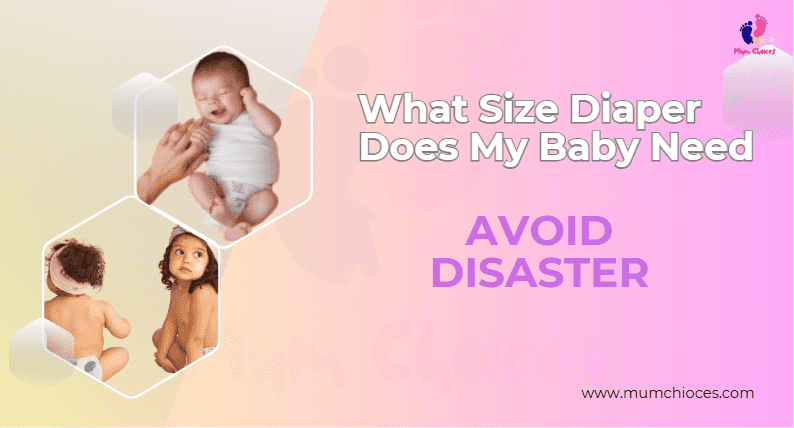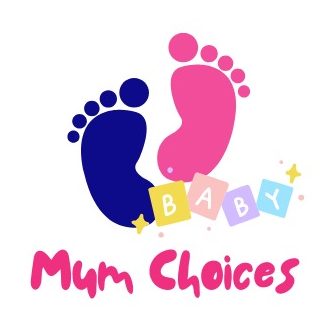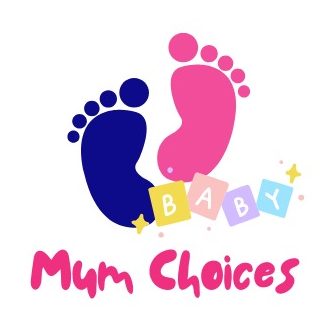One of the first things I struggled with when I became a parent was learning what size diaper my baby needed. I purchased a large pack of newborn diapers before my little one arrived. I thought they’d be perfect. But soon I discovered they were too snug! Infants grow quickly, and diapers can vary in fit by brand. If you have ever wondered “What size nappy does my baby need?, you’re not alone.
Selecting the proper size of diaper is crucial. It can also help your baby get some shut eye, synergize any leaks, and keep their skin soft and rash free. But because there are so many options and so many sizing systems, it can be confusing.
In this guide, I’ll break down how diaper sizes work for every stage of your baby’s development. I’ll walk you through how to tell when it’s time to size up and how to get the right fit.
Whether you’re excited about expecting a newborn or caring for an older baby or toddler, this guide will help you choose the right diaper.
We will go through the process of choosing diapers in a simple and stress-free way!
Let’s find that perfect fit
Why Diaper Size Matters

Choosing the right diaper size is just beyond being a good fit. This affects your baby’s comfort, prevents leaks, and keeps their skin in good condition. When a diaper fits well, your child can move around without any discomfort. This also ensures that everything is kept – no mess or spread in sleep time!
I learned this the hard way. When my daughter started getting red marks around her legs, I realized we’d outgrown Size 1! I never thought a diaper could cause discomfort like that, but it was a clear sign that it was time to size up. The right fit made a huge difference. Not only did the red marks disappear, but she also seemed more comfortable and happy in her new size.
Choosing the correct diaper size helps your baby stay dry and comfortable all day (and night) long. It also protects their sensitive skin from rashes. So, getting the right fit isn’t just about size—it’s about your baby’s well-being.
Understanding Diaper Sizes: A Weight-Based Approach
Choosing the right diaper size isn’t about how old your baby is—it’s all about their weight. Every baby grows at their own pace, and diapers are designed to fit based on weight, not age. As your little one grows, their diaper size will change too.
A 6-month-old child can weigh the same as a 9-month-old child. Therefore, the best diaper size for your baby depends on how much they weigh. It is important to check the weight range in the diaper package instead of following the recommendations of age.
Different brands can have slight variations in sizing. For instance, one brand’s Size 1 may fit more snugly than another’s Size 1. And this can occur even when both sizes are labeled for babies of the same weight. These small differences matter. They can influence the way the diaper fits around your baby’s waist and legs. If you find a brand that does work well, you might want to just stick with that.
You might also notice that some diaper sizes overlap. For example, a Size 2 diaper might fit babies weighing from 12 to 18 pounds. A Size 3 might fit babies from 16 to 21 pounds. This overlap gives you some flexibility. It also helps you transition to the next size when your baby’s weight is on the higher end of the current size.
Understanding these factors will help you choose the right diaper size for your growing baby. It ensures both comfort and leak protection!
Diaper Size Charts and Weight Recommendations
Here’s a simple chart to help you compare common diaper sizes and their weight recommendations:
Diaper Size Chart by Weight & Age
| Size | Weight Range | Age Range | Pampers | Huggies | Eco-Friendly Brands |
| Newborn (NB) | Up to 10 lbs | Birth to 1 month | Pampers Swaddlers | Huggies Little Snugglers | Honest Company, Bambo Nature |
| Size 1 | 8-14 lbs | 1-3 months | Pampers Swaddlers | Huggies Little Snugglers | Honest Company, Bambo Nature |
| Size 2 | 12-18 lbs | 3-6 months | Pampers Baby Dry | Huggies Little Snugglers | Honest Company, Seventh Generation |
| Size 3 | 16-28 lbs | 5-12 months | Pampers Baby Dry | Huggies Snug & Dry | Honest Company, Bambo Nature |
| Size 4 | 22-37 lbs | 12-24 months | Pampers Cruisers | Huggies Snug & Dry | Honest Company, Earth + Eden |
| Size 5 | 27+ lbs | 2-4 years | Pampers Cruisers | Huggies Snug & Dry | Honest Company, Earth + Eden |
| Size 6 | 35+ lbs | 3+ years | Pampers Cruisers | Huggies Snug & Dry | Honest Company, Earth + Eden |
Key Notes:
- Weight Ranges: Diaper sizes are generally based on your baby’s weight, not their age. Choose the size that best fits their weight, even if it’s a different age range.
- Brand Variations: Different brands may offer slight variations in sizing. Always check the weight ranges listed on the package for the best fit.
This chart gives a quick reference to the weight range for each size. Keep in mind that some brands may have slight differences. However, this is a solid guideline to help you get started.
What Size Diaper Does a Newborn Wear?
Newborns usually wear Newborn (NB) size diapers. These are made for babies under 10 lbs. They are small and snug, giving a better fit for tiny babies. Getting the right size from the start is important. Newborn diapers help prevent leaks and are gentle on delicate skin.
Some brands also offer Preemie sizes for smaller babies. These diapers are even tinier and fit babies weighing less than 5 lbs.
What Size Diaper Does a 6lb Baby Wear?
A 6lb baby will usually wear Preemie (P) size or Newborn (NB) size, depending on the brand.
- Preemie (P) Size: Made for babies under 6 lbs. It gives a snug fit for smaller newborns.
- Newborn (NB) Size: Fits babies up to 10 lbs. It may feel a bit loose on a smaller baby.
If your baby weighs 6 lbs, Preemie diapers might be a better fit at first. But some babies can wear Newborn size comfortably, especially if they have a bigger build. Try both sizes to see which fits best. Make sure there are no gaps or red marks.
What Size Diaper Does a 7lb Baby Wear?
Most babies around 7 lbs will be comfortable in Newborn size diapers. A diaper that feels too snug may not be the right fit. Red marks on the skin are another sign. If you notice these, try a different brand or switch to Size 1 sooner.
What Size Diapers Does a 9lb Baby Wear?
It depends on your baby’s body size and the diaper brand. A 9lb baby will usually wear either Newborn (NB) size diapers or Size 1 diapers.
- Newborn (NB) Size: Fits babies up to 10 lbs. This size should work well for a 9lb baby, offering a snug and secure fit.
- Size 1: Fits babies from 8 to 14 lbs. If the Newborn size feels too snug or leaves red marks, it’s time to move up to Size 1.
If your baby is nearing 10 lbs, consider transitioning to Size 1 soon. Watch for signs like leaks or red marks to know when it’s time to size up.
The same size diaper may vary slightly across different brands. So, it’s a good idea to check the weight range on the package before buying. This ensures the best fit for your baby’s needs.
What Size Diaper for Different Age Stages?
Understanding diaper sizes for each age stage keeps your baby comfortable and leak-free. Here’s a quick guide to help you choose the right size for your little one.
What size diaper should my 4-month-old baby be wearing?
At 4 months, babies usually weigh between 12 and 16 pounds. Most babies in this range wear Size 2 diapers. Check the weight range on the package to make sure you’re choosing the best fit for your baby.
What size nappy should my 6-month-old be in?
By 6 months, babies often have a growth spurt and gain 1-2 pounds. If your baby weighs between 16 and 20 pounds, Size 3 is usually a good fit. Babies closer to 20 pounds may need Size 4. Watch for signs like tight waistbands or red marks. These can mean it’s time to move up a size.
When to switch to pull-ups or training pants?
Pull-ups or training pants are usually introduced around age 2 or 3. This is when your child starts showing interest in potty training. Watch for signs like staying dry longer or showing interest in the toilet.
How to Know When to Change Diaper Size
Finding the right diaper size is key to keeping your baby comfortable and dry. As your baby grows, you’ll need to change their diaper size. But how do you know when it’s time?
Here are some signs:
1. Red Marks on the Skin
Check your baby’s waist and thighs during diaper changes. If you notice red marks or indentations, the diaper might be too tight. A good fit should be snug, but not tight enough to leave marks on your baby’s skin.
2. Frequent Leaks or Blowouts
A diaper that’s too small might not hold enough. If you notice leaks often, especially at night, or messy blowouts, it’s time to move to a bigger size. Larger diapers give better coverage and hold more.
3. Difficulty Fastening the Diaper
Diapers should close easily without pulling or stretching. If you have trouble closing the tabs or if they hardly reach across your baby’s belly, the diaper is too small. The right size should let the tabs fit comfortably in the middle of the waistband.
4. Your Baby’s Weight is at the Upper Limit
Diaper sizes are based on weight ranges. If your baby is close to the top of their current diaper’s weight limit, it’s a good idea to try the next size up. A bigger size will fit better and hold more.
5. Your Baby Seems Uncomfortable
Is your baby fussier than usual? Pulling at their diaper? Acting irritated after a diaper change? These could be signs that the diaper is too tight or doesn’t fit well. If your baby seems uncomfortable or tries to take off the diaper, a bigger size might help.
When in Doubt, Try the Next Size Up
If you’re not sure about sizing up, try a bigger diaper for a day or two. If it fits better, prevents leaks, and looks more comfortable, it’s likely the right size. Keeping a mix of sizes ready can make the switch easier.
Watching for these signs helps keep your baby comfy and dry as they grow!
Differences in Diaper Sizing Between Brands
Diaper sizes can be different across brands due to design, materials, and how they fit. Here’s a simple breakdown:
Huggies: Tends to fit a bit smaller. It’s snug, which works well for lean babies. They have elastic waistbands and “SnugFit” leg cuffs.
Pampers: Usually roomier, especially in their “Swaddlers” line. The “360 Fit” has a stretchy waistband, great for active babies.
Honest Company: These sizes are similar to Pampers but have a trimmer cut. They also use eco-friendly materials and bright, fun patterns.
Luvs: These are budget-friendly and cut wider, making them a good fit for babies with chunkier thighs.
Up & Up (Target): Similar to Pampers in sizing, but less stretchy.
Each brand’s design affects how the diaper fits, so finding the right one depends on your baby’s shape and size.
Pro Tips:
- Check the weight ranges, but keep in mind there may be variations. For example, Huggies Size 3 fits babies from 16–28 lbs, but Pampers Size 3 also fits the same range and may feel roomier.
- Many diapers have adjustable rise settings with multiple rows of snaps. This lets you customize the fit as your baby grows.
Organic Diapers vs Regular: Sizing Differences
Eco-friendly diapers, like Seventh Generation, Bambo Nature, and Dyper, fit differently. This is because they use different materials.
- Material: Plant-based fibers don’t stretch much. This makes the diaper feel stiff. Bambo Nature is slim. Seventh Generation is wider.
- Absorbency: Some eco-friendly diapers are thin. You may need to change them more often.
- Sizing Tips: Some eco-friendly brands suggest using a bigger size for overnight or babies with chunky thighs.
Recommendations:
- For Chunky Thighs: Try Dyper or Eco by Naty.
- For Sensitive Skin: Try Seventh Generation (fragrance-free) or Andy Pandy (made with bamboo).
How Should a Siaper Fit
Follow these steps:
- Positioning: Lay the diaper flat under your baby. Make sure the back (with the tabs) is aligned with their waist.
- Fasten Tabs: Angle the tabs downward toward the belly button. This ensures a secure fit. Make sure both tabs are even to avoid gaps.
- Check Snugness: Put two fingers between the waistband and your baby’s skin. It should be snug but not tight.
- Leg Cuffs: Pull out the frills around the legs. This helps prevent leaks. There should be no gaps.
- Rise Adjustment: Use the top snaps to adjust the height of the diaper for better tummy coverage.
Signs of Poor Fit:
- Too Small: Red marks, leaks at the legs, or trouble closing tabs.
- Too Big: Gaps at the legs or waistband slipping down below the belly button.
Pro Tips:
- Newborns: Position the back of the diaper higher to catch messy poops.
- Active Babies: Choose diapers with stretchy waistbands (like Pampers 360).
Final Note: Every baby’s shape is different. Ask for samples or trial packs before buying in bulk. This is especially important when switching brands. Sizes may need to change as babies grow. Be ready to adjust for growth spurts and body changes! 🌟
Bulk Buying vs. Sampling Small Packs
- For Newborns & Early Months: Stick to small packs or sample different brands. Babies grow fast, and fit varies by brand.
- For Sizes 3 & Up: Once you know what works, buy in bulk to save money. Look for deals on larger boxes!
- If Switching Brands: Always test with a trial pack first. Not all diapers fit the same!
Adjust as needed based on your baby’s growth and comfort! 😊
FAQs: Diaper Sizing & Fit
Parents, let’s clear up your diaper sizing questions!
How to Choose the Right Diaper Size for Your Baby
Your baby’s weight is the best way to find the right diaper size. Each size has a weight range printed on the package. Active babies might need a snugger fit to prevent leaks, while chunkier babies may need to size up sooner.
What Size Diapers Do Babies Stay in the Longest?
Babies tend to stay in Size 3 and Size 4 the longest. By this stage, their weight gain slows down, so they don’t size up as quickly. Many babies wear these sizes for several months before needing a change.
💡 Buying Tip: Instead of stocking up on newborn or small sizes, focus on Size 3 and 4 when buying in bulk. These sizes offer the best value over time.
Should I size up diapers at night for better absorption?
Yes, sizing up at night can really help prevent leaks. A bigger diaper holds more liquid, so it keeps your baby drier for longer. If you’re dealing with overnight leaks, try going up one size. You can also switch to overnight diapers for extra absorbency and peace of mind.
Do cloth diapers fit the same as disposables?
No, cloth diapers don’t follow the same sizing as disposables. Some brands make one-size-fits-all designs with snaps or Velcro to adjust as your baby grows. Others use weight-based sizes, like newborn, small, medium, and large. To get the best fit, always check the brand’s size guide.
What size diapers should I use for twins or premature babies?
If you have twins or a preemie, start with preemie or newborn sizes. Choose the size based on their weight. Some brands even make micro-preemie diapers for the tiniest babies. Twins don’t always grow at the same pace. Check the fit often and size up when needed.
Can I use the same sizing rules for cloth and disposable nappies?
Cloth diapers are different from disposable ones. They usually have adjustable sizes. Disposable diapers use fixed weight ranges. Always check the size guide. The diaper should fit tightly around the waist and legs. This helps stop leaks.
Conclusion & Final Tips
Finding the right diaper size may seem tricky, but it all comes down to weight and fit—not age. If you’re asking, “What size diaper does my baby need?”, always check the weight chart. Watch for signs that it’s time to size up or down.
A well-fitting diaper should feel snug yet comfortable. It should not leak or leave red marks. If diapers seem too tight, they may cause discomfort. Move up a size if you notice marks or frequent leaks. If diapers look loose and saggy, consider sizing down.
As babies grow, their body shape changes. Be ready to adjust sizes as needed. Every baby is different, so focus on fit rather than age.
💡 Your turn! Have you found a diaper brand or size that works best for your baby? Share your experience in the comments—we’d love to hear from you! 😊

